The people of Ecuador are NOT happy with their government.
Demonstrations across Ecuador demand changes for the benefit of all Ecuadorians, not just the chosen few.
Download a translation of this article into Spanish…
Please watch the videos below…

Please watch the interview with Carlos Heredia…
https://www.bitchute.com/video/6tFQzseX9ozS/
Demonstrators from the country’s Indigenous community — which makes up over a million of Ecuador’s 17.7 million inhabitants — launched an open-ended anti-government protest on Monday, June 13, 2022 that has since been joined by students, workers and others.
The demonstrations have blocked roads across the country, including highways leading into the capital Quito. Indigenous protesters demanding cheaper fuel in Ecuador defied a state of emergency, pressing on with road blockages now in their seventh day.
Protestors believe that President Guillermo Lasso should be less focused on following International Monetary Fund (IMF) policies because the script imposed by the IMF is worsening the economic effects caused by the COVID-19 pandemic on the country's poor.
Ecuador's $6.5 billion deal with the IMF ends this year. The plan included tax hikes and eliminating subsidies but failed to improve the country's fiscal deficit and the promises did not improve the reality on the ground.
A TIMELINE OF EVENTS:
With the government in crisis, President Guillermo Lasso delivered an annual report to the nation that ultimately triggered the people to express their dissatisfaction by taking their protests into the streets across the country.
Tuesday, May 24, 2022
In his annual report to the nation at the National Assembly, President Lasso insisted that the country has “turned the corner” in its recovery from the Covid-19 pandemic and that progress is being made in the fight against crime.
Lasso said “some great things have been accomplished” during the past year. He said the government’s vaccination program against the Covid-19 virus was “one of the most successful in the world” and has saved thousands of lives. “At one point, we delivered 420,000 thousand doses a day, the highest rate of any country in the world.
In March, Lasso called the Assembly a “den of obstruction” and said he would rule the country by “decree and resolutions.” His comments followed the rejection by the Assembly of his efforts to reform labor law and to attract investment.
SOURCE:
Unions plan mobilize in Ecuador against government policies
Wednesday, May 25, 2022
"We will mobilize, in our right to resistance, because the streets are what we have left, so that the Government listens to our proposals.
Regarding the report of President Guillermo Lasso, which was presented on May 24, 2022 on the occasion of one year of his administration, Edwin Bedoya, the vice president of Cedocuc, noted that the president did not discuss social security, nor the cut in the budget for health and education. Bedoya stated that the Chief Executive:
“says nothing about the unemployed left by the Humanitarian Law and which still leaves workers who earn less than the basic salary. The Government does not want to discuss these issues.”
A number of unions and social organizations in Ecuador announced that on June 13 and on June 22 they planned to mobilize throughout the country to deal with the critical situation presented by various sectors, including education, health and citizen security.
Unitary Front of Workers (FUT)
General Union of Workers of Ecuador (UGTE)
Central de Tabajadoras y Trabajadores (Cedocuc) which is part of the FUT
National Union of Educators (UNE)
Confederation of Indigenous Nationalities of Ecuador (CONAIE) https://twitter.com/CONAIE_Ecuador
Ángel Sánchez, the president of the FUT, stressed that they were expressing their rejection of the privatization of strategic sectors and the high cost of living.
José Villavicencio, the president of the General Union of Workers of Ecuador (UGTE), claimed that the chief executive is lying. The union leader delved into the employment figures presented by Lasso in his recent government management report. Villavicencio believes that the president should compare figures from March 2019 to March 2022; not 2020 and 2021, which are the years of the pandemic.
"The figures that he showed [are] a rebound from the pandemic, not a recovery."
Pancho Escandón G tweeted:
"...the report to the nation was a farce that tried to falsify reality. In real Ecuador there are much more disappointments than the achievements of the regime..."Here is my opinion…”

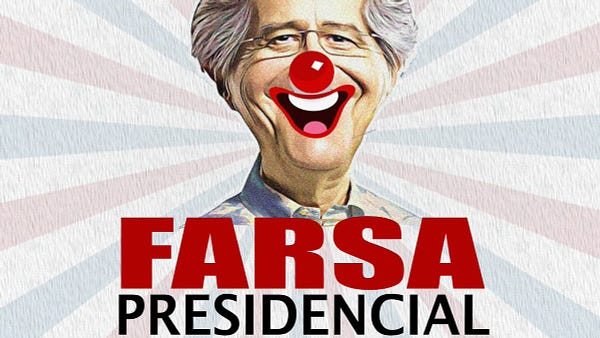
Peoples and nationalities that make up the Confederation of Indigenous Nationalities of Ecuador (CONAIE), called for an earlier permanent mobilization starting June 13, 2022 and presented an alternative report to the nation; “From the reality of the peoples and organizations and within the framework of the 200 years of Independence.”
Violence is a growing problem. According to official figures from January 1 to April 25, 2022, 1,241 intentional homicides were confirmed in Ecuador, which represents almost 50 percent of the murders committed in all of 2021 (2,491), in just four months.
Ecuadorian teachers and students continued a hunger strike for the salary increase and for enforcing the proposed reforms to the Bilingual Intercultural Education Law (LOEI)
SOURCE:
https://www.telesurtv.net/news/gremios-movilizaran-ecuador-gestion-gobierno-20220525-0031.html
Before the demonstrations began, the indigenous movement delivered a document to the Presidency with the following 10 proposals:
1. Reduction and no more increase in fuel prices. Freeze diesel at $ 1.50 and extra gasoline and ecopaís at $ 2.10. Repeal decrees 1158, 1183, 1054 and enter into the process of targeting the sectors that need subsidies: farmers, peasants, transporters, fishermen, among others.
2. Economic relief for more than four million families with a moratorium of at least one year and renegotiation of debts with reduction of interest rates in the financial system (public, private and cooperative banks). No to the seizure of assets such as houses, land and vehicles for non-payment.
3. Fair prices for farm products: milk, rice, bananas, onions, fertilizers, potatoes, corn, tomatoes and more; no to the collection of royalties on flowers. So that millions of small and medium farmers can have guaranteed livelihoods and continue producing.
4. Employment and labor rights. Public investment policies to stop the precariousness of labor and ensure the sustainability of the popular economy. Demand payment of debts to the Ecuadorian Social Security Institute (IESS).
5. Moratorium on the expansion of the extractive mining/oil frontier, audit and integral reparation for socio-environmental impacts. For the protection of territories, water sources and fragile ecosystems.
6. Repeal of Decrees 95 and 151.
Respect for the 21 collective rights: comprehensive bilingual education, indigenous justice, free, prior and informed consultation, organization and self-determination of indigenous peoples.
7. Stop the privatization of strategic sectors, patrimony of Ecuadorians: Banco del Pacífico, hydroelectric plants, IESS, National Telecommunications Corporation (CNT), highways, health, among others.
8. Stop price gouging by implementing price control policies and end speculation in the market of basic necessities. Stop price abuse in industrialized products in supermarket chains.
9. Health and education. Urgent budget in the face of hospital shortages due to lack of medicines and personnel. Guarantee the access of youth to higher education and improvement of infrastructure in schools, colleges and universities.
10. Security, protection and generation of effective public policies to stop the wave of violence, hired killings, delinquency, drug trafficking, kidnapping and organized crime that keep Ecuador in fear.
Monday, June 13, 2022



PROTESTS BEGIN
Indigenous groups in Ecuador blocked some highways with mounds of earth and burning tires on Monday, kicking off what they said will be an indefinite protest against the economic policies of conservative President Guillermo Lasso.
The mobilizations called by the Conaie and supported mainly by the Feine, the Fenocin and the Popular Front unions have caused the closure of several roads in different provinces of the country , since the early hours of this Monday, June 13, 2022.
In the first government report , the authorities reported that there are some 3,800 people demonstrating and that the mobilizations are concentrated in Imbabura, Cotopaxi and Pichincha . In addition, the Collas – Oyacoto road is the only one that remains closed.
The government has deployed police operations to clear the roads, under the warning of legal consequences for the paralysis of public services.
SOURCE:
Tuesday, June 14, 2022


Ecuador's native groups to increase protests after leader was arrested
Conaie Chairman Leónidas Iza, arrested on Monday, June 13, 2022 in the Andean province of Cotopaxi after visiting protesters barricaded across the Pan-American Highway, is a charismatic leader of peasant movements.
He rose to local recognition following protests in 2019. He was encouraged to assume indigenous leadership at the national level in 2021.
A member of the Kichwa-Panzaleo nationality and donning a traditional maroon poncho and a black hat, Iza has capitalized on his anti-capitalist stance. Born in 1982 in the community of San Ignacio, Iza is the son of José María Iza Viracocha, one of the leaders of the first indigenous uprising of 1990.
The indigenous leader also called for the radicalization of “protest in every corner of the country,” and asked international organizations to pay attention to what is happening in Ecuador.
Iza is enormously influential among Catholic youths. Born in 1982, he became leader of the Provincial Committee of Pachakutik (Conaie's political arm) in 2013 and was elected chairman in 2016 president of the Indigenous and Peasant Movement of Cotopaxi (MICC). From that position, in 2019 he became one of the visible faces of the demonstrations that paralyzed Ecuador between October 1 and 13, against economic measures adopted by then-President Lenín Moreno.
During that uprising, the indigenous movement captured eight police officers, for which Iza and others faced kidnapping and terrorism charges. He was pardoned by Congress in March along with other 267 activists.
Iza was elected president of Conaie with a clearly anti-extractive agenda and to enforce the application of the 21 collective rights that protect the fourteen native nationalities of Ecuador. His tenure spans through 2024. The same demands were conveyed to Lasso's administration in Monday's protests.
”Now this people have not risen to go to a dialogue table, this people have risen so that, in a public way, you (President Lasso) respond to the demands that (for) a year we have put on the Government's table,” Iza said before refusing to bargain with the Executive.
Known for his anti-capitalist stance, Iza has published in 2020 together with other indigenist authors a book called The October Rebellion in Ecuador, which summarized his ideology.
The group was angered following Monday's arrest of community leader and Conaie Chairman Leónidas Iza. Group Vice-President Zenalda Yasacama said in a video distributed through social media that “after the arrest, we do not know where Iza was transferred” and warned that “we will hold the government responsible for any act that attempts against his life and integrity.”
Ecuador's Confederation of Indigenous Nationalities of Ecuador (Conaie) Tuesday launched an appeal to up protests against the government of President Guillermo Lasso by staging “a great indigenous and popular revolt.”
Marlon Vargas, head of Confenaie, Conaie's Amazonian branch, confirmed the call for mobilization of the eleven indigenous nationalities that make up the organization. Vargas also rejected Iza's “arbitrary, illegal and illegitimate detention.” While demanding Iza's release, she also called on “all nationalities of the Amazon region to radicalize.”
Lasso's administration has warned episodes like the ones of 2019 to happen again.
SOURCE:
Tuesday, June 14, 2022

Ecuador indigenous leader freed from detention, vows protests will continue
Wednesday, June 15, 2022
Protests in Ecuador will continue until President Guillermo Lasso solves economic and environmental issues affecting the country, indigenous leader Leonidas Iza said on Wednesday after he was freed from detention on a judge's order.
Iza was released late on Tuesday following a ruling by a judge in the city of Latacunga. He had been detained for about 24 hours after the government said he led road blockades and other allegedly violent acts that halted public services.
Iza's lawyer called the detention illegal, but the government has said he will be tried.
"While the most sensitive problems aren't resolved, we're going to continue supporting this fight, which is constitutional," Iza said in an address over social media.
Access roads north and south of Quito, the capital, have been blocked since Monday by protesters demanding that Lasso freeze the price of gasoline, declare a moratorium on small-farmers' bank debts, and limit oil and mining expansion.
Demonstrators have said the protests, which have been marked by invasions of oil fields, the torching of police cars and the detention of some police by protesters, will be indefinite.
"It's not just a whim of (Iza's) to call this march. It's because Ecuadoreans feel the high cost of living," Carlos Sucuzhanay, head of indigenous organization Ecuarunari told local media. "We want the president to reorient himself to work in service of the country."
CONAIE, the group led by Iza, said on Twitter on Wednesday that there were protests in several of Ecuador's Andean and Amazon provinces.
State oil company Petroecuador has lost some 2,500 barrels of oil as a result of sabotage and halted operations at its facilities.
A group of people tried to enter one of Petroecuador's stations in the province of Sucumbios. The Ministry of Defense confirmed 10 soldiers were wounded in the clash.
"Our door is open to dialogue, but we won't give in to violent groups that seek to impose their rules," Lasso wrote on Twitter.
At least 20 people have been detained during demonstrations, while some 15 patrol cars have been damaged, with several attacks carried out on private property, according to the government. Iza said that at least 14 people have been injured by the police.
Lasso has said he will not allow protests to affect economic recovery and any vandalism will be punished.
SOURCE:
Ecuador rises up again – national strike against banker president Lasso
Thursday, June 16, 2022
Thursday, June 16, 2022

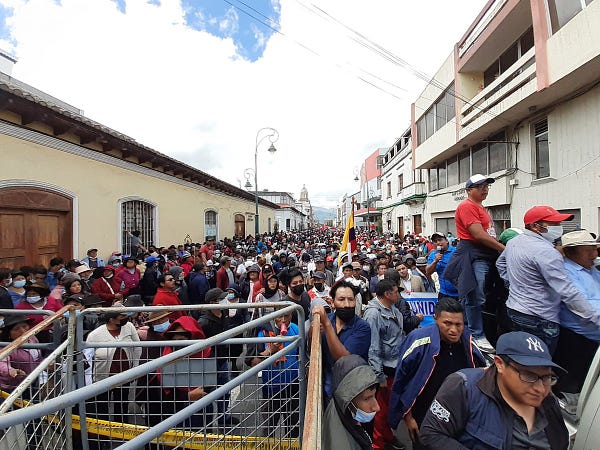
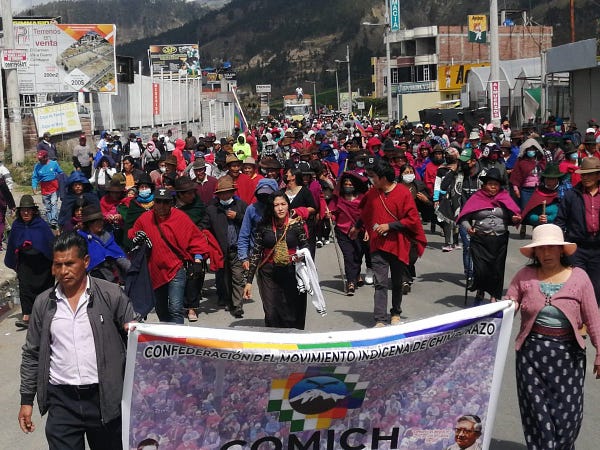
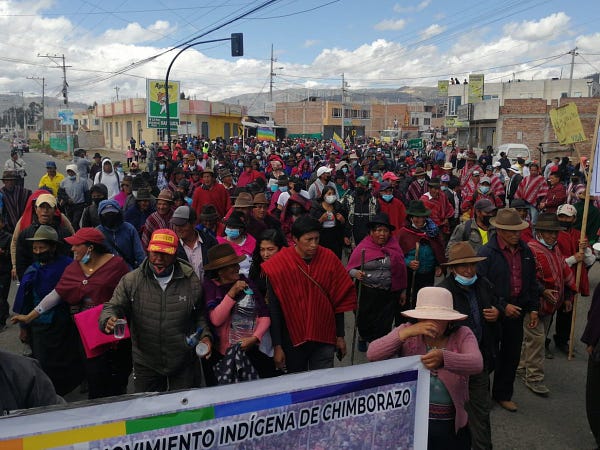
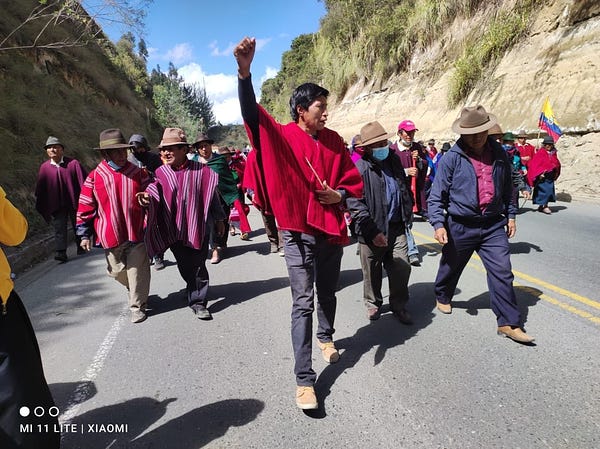
On June 13, a new national strike began in Ecuador, announced by the Confederation of Indigenous Nationalities (CONAIE), demanding better economic conditions. Demands include the freezing of the price of gasoline, price controls on basic foodstuffs, and opposition to the privatisation plan. These demands challenge the impositions of the International Monetary Fund (IMF) head on.
Lasso’s government
On 24 May 2022, Guillermo Lasso completed his first year in power. With a volatile economic and social situation, and whilst the majority of citizens living in insecurity, Ecuadorian politics has arrived at a critical state on the first anniversary of the banker-president’s government.
Lasso broke his electoral alliance with the Social Christian Party, and broke an agreement with correísmo [the political tendency aligned with former president Rafael Correa], which offered him the possibility of governing at the parliamentary level. The tenuous legislative alliance that Lasso preferred to forge with the centrists of the Democratic Left and the political wing of the indigenous movement Pachakutik proved lethal for those political forces, for whom this manoeuvre has incurred significant internal divisions. As a result of the erratic political operations in the Assembly, the Executive has only managed to get one of its bills approved (and in a very controversial manner), and it has suffered numerous defeats.
Despite the increase in the minimum wage, the poor figures for job creation in a country devastated by a lack of opportunities, constitutes the main negative feature of his mandate. In the other key axis of his campaign – security – government inaction goes hand-in-hand with chilling crime figures and an unprecedented and accelerating prison crisis. The president’s only response to his failure and the failure of the IMF’s policies has been to blame and threaten his political opponents, including the powerful Social-Christian right wing that rules the country’s second largest city, Guayaquil.
As far as his relationship with other political and social groups outside the Assembly is concerned, his behaviour has followed the same trend. Singling out the social leaders as “conspirators”, while pretending to be in favour of dialogue, he has threatened them with imprisonment, as in the case of the indigenous CONAIE leader, Leonidas Iza.
This administration privileges the interests of a specific sector of the capitalist elites above the critical and central problems that the majority of the country is going through. In his year in power, Lasso has above all resorted to conflict and violence as tools of administration. It has been a year in which his utter mismanagement has radiated disrepute across the entirety of an already discredited capitalist political system.
Protests
“The social struggle is based on ten demands and proposals for the great #NationalMobilisation on June 13,” CONAIE, the country's main indigenous organisation, said on Twitter.
“Those of us who feel the weight [of] the crisis, high prices, those of us who produce, take care of the family economy and nature, join in,” they added after announcing an ‘all out’ protest.
The call for a national strike has had a big echo among indigenous people, youth and workers, given the attacks they have suffered in recent years / Image: Gabriel Unda
The demands of the movement include: “the reduction of fuel prices, the cancellation of the debt of the peasants with the public bank, respect for collective rights, that state assets are not privatised, control and stabilisation of the prices of basic products.”
The five indigenous organisations agreed that the protests will be carried out on an escalating basis. They will be first in the provinces and the movement will also have an all out character. Leonidas Iza, president of the CONAIE, explained: “Since Monday, after a year of dialogue in which we were not listened to, we summoned not only the organisations, but also ordinary citizens [onto the streets.]”
Meanwhile, the Minister of the Interior, Patricio Carrillo, launched a campaign to criminalise the protest, describing the demonstration as “a week of blocked roads and oil wells, kidnappings of police and military personnel [and] looting” and he claimed that the indigenous people would “disguise [the protest] as a social struggle in order to provoke victimisation”. President Guillermo Lasso called the protesters “hooligans” who want to cause chaos. “My obligation as president is to guarantee Ecuadorian families the possibility of moving freely.”
The call for a national strike has had a big echo among indigenous people, youth and workers, given the attacks they have suffered in recent years. On its first day, the strike was very successful. Various layers across the country mobilised: from the coast, to the central mountain range, and the east of the country. In Quito and Cuenca, students also joined the movement, and protested in the streets.
The indigenous organisations headed by CONAIE mobilised in their provinces, blocking roads and closing access to the cities. The highest level of mobilisation took place in the provinces of Cotopaxi, Azuay, Pastaza and Sucumbíos.
The Minister of the Interior, Patricio Carrillo, on the afternoon of the first day of mobilisation claimed that violent acts had been committed by the demonstrators, and in particular that members of the National Police in Saraguro had been “kidnapped” for a few hours before being later released. The general commander of the National Police of Ecuador, Fausto Salinas, threatened the “progressive [deployment] of force protocols” in the event that the demonstrators resort to “violence or vandalism.”
Thus we see that this government, which is powerless in the face of crime, drug trafficking and hired assassins, has no hesitations about sending in the police to violently repress protesters.
Leonidas Iza detained
Early in the morning of Tuesday 14 June, the Ecuadorian Police reported through Twitter that they had arrested Leonidas Iza, president of CONAIE, on suspicion of “committing crimes”. Iza, who had been the main leader of the protests, was then placed in a temporary detention room for a ‘flagrancy qualification hearing’. This arrest came on the second day of CONAIE’s call for national mobilisations in rejection of the Lasso government’s policies.
CONAIE declared that Iza’s detention was illegal and denounced it for failing to comply with due process. Lenin Sarzosa, Leonidas Iza’s lawyer, wrote that his client’s arrest was illegal because it did not follow a judge’s order and there is no police report, and in a public statement he reported that Iza was transferred to the flagrante delicto unit in Quito.
The arrest of Leonidas Iza did nothing but harden the protest and radicalise the spirit of the protesters leading the indefinite national strike. “We call on our organisational structure, to RADICALISE the de facto measures, for the FREEDOM of our leader and for the dignity of our struggle,” CONAIE stressed.
Having no answers about the whereabouts of Leonidas Iza, five police officers were detained by members of the Jatarishum organisation, who placed them on a truck and took them to one of their communities. This Tuesday, groups of university students also joined the indefinite protest.
Finally, in the early hours of 15 June, Leonidas Iza was released on caution, but he is under threat of returning to jail “if he breaks the law”. Clearly Lasso’s capitalist government aims to decapitate the movement through repression.
However, things are not so simple. The beginning of a new popular uprising in Ecuador is not the result of the whim of the CONAIE leaders, although leadership obviously plays an important role in any movement. The popular protest is a response to the worsening living conditions of the masses. It is a radical rejection of the capitalist policies of the IMF that the Lasso government has been applying. In these conditions, the government is playing with fire. Their repression can have the effect of radicalising the movement further.
As the CONAIE national strike enters its third day, indigenous columns are approaching the capital, Quito.
Perspectives for the movement
This national strike movement takes place in conditions that are very propitious for its victory: the government of banker-president Lasso has lost enormous amounts of prestige. Significant divisions are opening up within the ruling class. And, of course, we have magnificent traditions of struggle of the working people of Ecuador.
However, this is not the first time that there has been an uprising against a capitalist government in the country. Time and time again over the last 25 years, the poor peasants, the working class, and the youth have overthrown right-wing governments (Bucaram, Mahuad, Gutiérrez). And two and a half years ago, they staged a heroic insurrectionary uprising during the ‘Red October’ of 2019.
It is necessary to learn the lessons of those earlier movements, and above all the lessons of ‘Red October’, so that this national strike may succeed.
In the first place, it is crucial to achieve the unity of the peasant organisations with those of the workers and the student youth. It is necessary to draw new sectors into the fight. The indigenous peasants play a crucial role in any mobilisation. But to win they need the participation of the workers and youth in the main urban centres. The programme of demands affects all the exploited sectors, and unity is strength.
In 2019, the extreme sectarianism of the CONAIE leadership towards correísmo pushed them to form an unnatural pact with Lenín Moreno that deactivated the movement and frustrated its potential. The same mistake cannot be made a second time.
Moreover, we must state things clearly as they are. In 2021, in the second round of the presidential elections, the Pachakutik indigenous movement made a serious mistake by advocating a spoiled ballot instead of giving critical support to the UNES Arauz correista candidate. That error, the main responsibility for which lies with the Pachakutik candidate, Yaku Pérez, but for which Leonidas Iza must also share blame, is what brought the banker Lasso to power.
Now, CONAIE has correctly called for an indefinite movement. It is necessary to organise the structures of the movement in the broadest and most democratic way possible in order to incorporate all sectors of the working people into the struggle. In the past, the People's Assemblies have played that role. It is necessary to create such organisations in all provinces and at the national level to give the struggle an organised form.
In the face of police repression, which has already begun and threatens to intensify, it is necessary to organise workers’ self-defence, following the example of the Indigenous Guard and the militant youth of October 2019.
As for the political programme and the objectives of the movement, it is necessary to be clear that in the context of the world capitalist crisis, and particularly the impact that it has on a country dominated by imperialism like Ecuador, it will be very difficult to obtain concessions from the government. Rather, if the movement develops and gains strength, it can take on an insurrectionary character like in 2019. It is really about bringing down Lasso. If the president does not respond to the interests and aspirations of the majority, he must be removed from office and the majority (workers, peasants, indigenous people, youth) should govern through their own organisations (Peoples’ Assemblies, etc.).
Extend and broaden the indefinite national strike!
Unity of the working people against the banker Lasso and the IMF!
Repudiation of the external debt – let the capitalist oligarchy pay for the crisis!
For Peoples’ Assemblies and Indigenous Guard!
Lasso out! The working class shall rule!
SOURCE:
https://www.marxist.com/ecuador-rises-up-again-national-strike-against-banker-president-lasso.htm
Cuenca faces LP gas shortage from strike roadblocks; Government says it is now open to talks
Thursday, June 16, 2022
Most of Cuenca’s LP gas trucks were off the streets Wednesday and customers going to the supply stores were greeted with “no gas” signs. “The supply of gas to the city has been stopped by the roadblocks from the coast,” says Gerardo Maldonado, general manager Austrogas, one of Cuenca’s major gas distributors. “We receive our supply from Guayaquil and Machala and the highways are blocked and the gas cannot get through. We have told the local suppliers we are not able to provide delivery until the strike is over.”
Cuenca gas suppliers tell customers they have no gas to sell.
While some independent suppliers say they have no gas to sell to the public others are restricting sales to one tank per customer. Suppliers say they are, during emergencies, obligated to provide gas to hospitals and other “critical need” facilities ahead of households.
Maldonado says he is negotiating with groups maintaining the road blocks on the Cuenca-to-Machala and Zhud-to-Guayauqil highways, the routes that gas supply trucks take. “So far, there is no progress and the problem is that there are multiple blockages,” he says. “Even if we reach an agreement with one group another group up the road may refuse.”
Azuay Province Governor Matías Abad said Wednesday he is “working on a solution” but did not offer details.
According to Maldonado, the only solution available may be the one used during the October 2019 strike. “The army will need to lead a convoy of gas trucks from Guayaquil, tearing down the roadblocks ahead of it. The strikers don’t want to fight the army.”
SOURCE:
Friday, June 17, 2022
https://www.bitchute.com/video/iYPFeUrKm1vF/
Friday, June 17, 2022

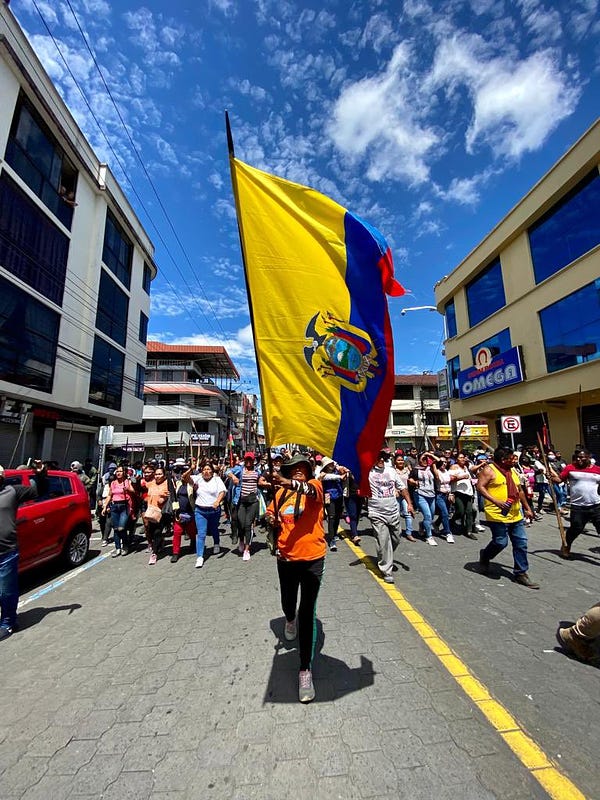
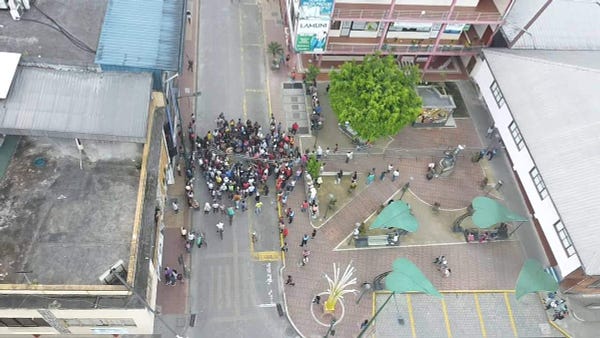
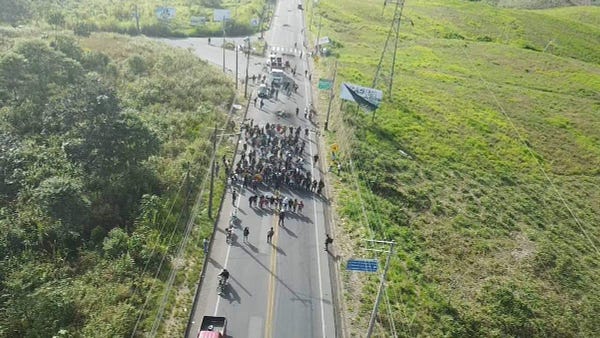
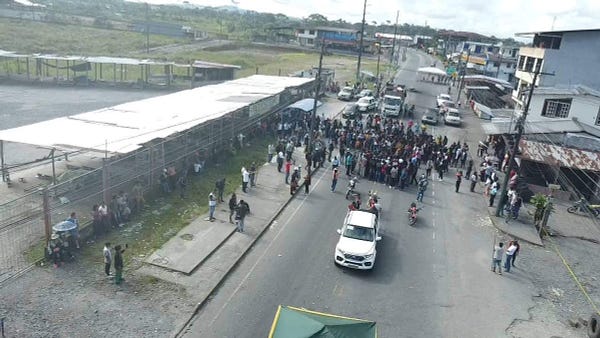
Friday, June 17, 2022

Friday, June 17, 2022

Friday, June 17, 2022

Friday, June 17, 2022
Lasso says he’s ready to talk; New roadblocks isolate Cuenca suburbs; Corpus Christi kicks off with huge crowd following peaceful protest in Parque Calderon
Friday, June 17, 2022
As the anti-government strike enters its fifth day, the Catholic Episcopal Conference, Amnesty International, the National Assembly and the city of Cuenca have offered to mediate talks between the Confederation of Indigenous Nationalities (Conaie) and the government.
An estimated crowd of 500 gathered at the provincial government building Thursday afternoon to support the national strike.
Strike leader and Conaie President Leonidas Iza said he is ready to talk but sees no “concrete actions of good will” from President Guillermo Lasso. He insists major concessions must be made by the government before talks can begin.
In a three-minute video message released Thursday night, Lasso insisted he is prepared to negotiate but will not hesitate to use “progressive force” against violent protesters. One unnamed cabinet official said the option of an emergency declaration is “on the table” if an agreement to end the strike is not reached soon. He said such a declaration would involve a large-scale military intervention.
In its offer to host talks, Monsignor Luis Cabrera, archbishop of Guayaquil, said the government must recognize the hardships that many Ecuadorians are suffering. “This must be acknowledged as a starting point to talks and for finding solutions that will end the strike,” he said.
In his mediation offer, Mayor Pedro Palacios, said Cuenca is “removed from the epicenter” of the protest and can provide the “relaxed atmosphere necessary for reaching an agreement.”
In his comments, Lasso said he was encouraged that protests have led to “very few” injuries and arrests and only limited violence. “We are actively looking at mechanisms to relieve the debts of the poorest people and provide the assistance they need.” He added there are no plans to privatize public institutions or services, one of Conaie’s demands.
Cuenca city officials say they hope Corpus Christi activities will help relieve anxieties about the national strike.
In Cuenca, more roads were blockaded Thursday, isolating several suburban neighborhoods. The Transportation Ministry’s list of blocked highways, indicates that the only option for long-distance travel from the city is by air to Quito and Guayaquil.
Among the new roadblocks were two on the E35 autopista to Azogues. As of Friday morning, the populous Challuabamba surbrub was isolated.
In downtown Cuenca, police removed barriers on several streets Thursday and city officials insisted they would keep the city open.
A large protest march arrived at Parque Calderon late Thursday afternoon following a pledge by University of Cuenca President Maria Hermida that the event would be peaceful and not disrupt Corpus Christi activities. University students were joined by members of two teachers’ unions and the United Workers Front, swelling the crowd to more than 500, according to police.
LP gas distributors said no progress was made Thursday to bring new supplies to the city as lines formed at the gas supply companies offering one tank per customer. Other suppliers posted “no gas” signs and were closed entirely.
Gerardo Maldonado, manager of regional gas distributor Austrogas said he saw no immediate solution except for military convoys to transport gas from the coast but said this would not happen until next mid-week at the earliest.
Following the late afternoon protest, the weeklong Corpus Christi celebration, with what organizers said was one the largest opening night crowds ever, got underway in Parque Calderon. They estimated 8,000 to 10,000 filled the plaza and side streets to buy sweets and watch the fireworks show at the cathedral.
When he made his offer to host negotiations between strike leaders and the government, Palacios praised Cuenca residents for “maintaining the calm” and avoiding a repeat of the violence that occurred in October 2019. “Among the country’s larger cities, Cuenca is the only one that has not experienced acts of violence and vandalism.”
In pre-dawn hours Friday morning, Ecuador Armed Forces and National Police carried out roadblock cleaning operations on the Cuenca-Giron-Machala highway, including at the Y-intersection in Tarqui. The transportation ministry said the operation was intended to “open and maintain” a supply route between Cuenca and the coast.
SOURCE:
State of emergency declared in Ecuador
Saturday, June 18, 2022
EMERGENCY CEDREE:
Ecuador's President Guillermo Lasso Friday decreed a state of emergency in three provinces for the next 30 days following uprisings by indigenous communities.
In a broadcast message, Lasso explained the measure involved the provinces of Cotopaxi, Imbabura, and Pichincha (Quito).
He also announced that in order to alleviate the current economic crisis, the Government would up the value of a state bond given to the poorest, pardon overdue loans of up to US$ 3,000, and subsidize half the cost of urea, a fertilizer used in agriculture.
Lasso made these announcements after the Confederation of Indigenous Nationalities of Ecuador (Conaie) called for a nationwide strike.
Other measures will include a declaration of emergency for the public health system, a 100% increase in the budget for intercultural education, an agricultural loan of up to US$ 5,000 at a 1 % over 30 years, and no increase in the price of fuels, and no privatization of utilities.
As per the new Decree, the right to freedom of association and assembly is suspended in the three provinces' spaces 24 hours a day, in addition to a curfew to be enacted in Quito from 10 pm to 5 am, with the usual exemptions, such as healthcare staff, law enforcement officers, logistics and people traveling to and from airports for scheduled flights during curfew hours.
“United, sitting at a table, we will find solutions that will alleviate the situation of Ecuadorian families,” Lasso stressed.
The Conaie gave an ultimatum to the Lasso administration late Thursday to give answers to the list of petitions demanded by the indigenous movement and refused to dialogue until the 10 petitions had been granted.
Conaie also called on its members not to allow vandalism or violence and to identify infiltrators who want to generate chaos. “The protest must be carried with a clear agenda, dignity, and collective conscience.”
SOURCE:
https://en.mercopress.com/2022/06/18/state-of-emergency-declared-in-ecuador
Lasso declares state of emergency in three provinces as Quito protests intensify, announces concessions to Conaie demands; Cuenca remains calm but isolated
Saturday, June 18, 2022
President Guillermo Lasso declared a state of emergency Friday night for three provinces hardest-hit by the indigenous anti-government strike. Under the declaration, Pichincha. Cotopaxi and Imbabura Provinces are under restrictions for public gatherings and movement as well as a night-time curfew.
Protesters attempt to push down barricades Friday afternoon in Quito. Police later used tear gas to push back the crowd.
Lasso made the decision following a day of sometimes-violent protests in Quito and the announcement by strike leader Leonidas Iza of an indigenous march on the capital early next week.
During a brief address to the nation, Lasso also announced several measures responding to Confederation of Indigenous Nationalities (Conaie) demands for ending the protests. Following Lasso’s announcement, Iza called the government concessions “a start” but said the strike would continue. He criticized the emergency declaration, calling it “a possible prelude to government violence against the people.”
The state of emergency in the three provinces allows the government to disburse crowds in public spaces “by the use of reasonable force, if necessary” and establishes a 10 p.m. to 5 a.m. curfew. The declaration will be in force for 30 days, according to Lasso.
The concessions the president offered to Conaie demands include: a doubling of the funding for intercultural education; an increase to $55 a month for those in extreme poverty (the human development bonus); declaration of emergency for the public health and Social Security heath systems; a 50% subsidy for small farmers on the price of fertilizer; agricultural loans of up to $5,000 at 1% interest with a 30-year term; and forgiveness of BanEcuador overdue loan penalties up to $3,000.
In addition, Lasso said there would be no increase in prices for diesel fuel, regular gasoline and household LP gas. He also pledged that the government would not privatize public services or facilities.
Violent protests in Quito
Quito endured a second night of sometimes violent protests in the historic district, with police using tear gas on several occasions to push back a crowd from barricades protecting the Presidential Place and Plaza Grande. City officials said that three traffic lights were destroyed while residents reported numerous acts of vandalism.Quito Mayor Santiago Guarderas thanked Lasso for the emergency declaration but called on the government and Conaie to begin talks immediately. “The city has only five days of food and other essential supplies before we reach a crisis situation,” he said. “Many gasoline stations are out of fuel and roadblocks are preventing new shipments from arriving. We have enough supply for essential service vehicles but this could be exhausted within a matter of days.”
Guardera added that protests have not reached the level of violence of those in 2019 but asked the government to provide more police and military personnel to maintain order.
Cuenca remains calm but needs gas
Cuenca was peaceful Friday as city officials met with Azuay Governor Matías Abad and army brass to arrange supply truck convoys next week from the coast. “The most critical need is cooking gas and we understand that we will receive new shipments early next week,” said Cuenca Mayor Pedro Palacios. “The military will organize the passage of trucks through the obstacles on the Cuenca-Pasaje highway and these will bring food, essential household supplies as well as LP gas.”Roadblocks were cleared from the Azogues autopista to Challuabamba Friday morning but police were forced to return on at least three occasions during the afternoon when protesters attempted to reconstruct barricades.
According to transit police, all highways leading to and from Cuenca were blocked as of midnight Friday.
SOURCE:
Saturday, June 18, 2022
Saturday, June 18, 2022
They shoot at the vehicle of our organization in which our Pdte moves. @LeonidasIzaSal1, impacting the front window while parked, he is fine. We warn of this in the context of the state of emergency and the belligerent attitude of the Government.
Saturday, June 18, 2022

Saturday, June 18, 2022



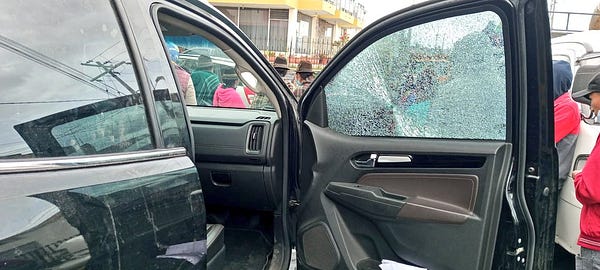
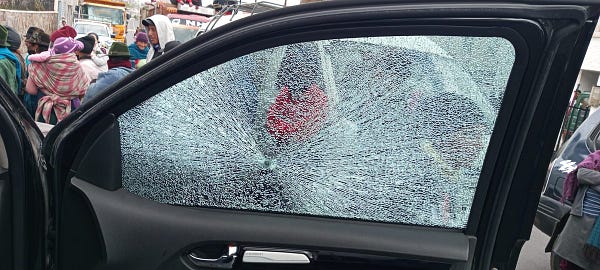
https://mobile.twitter.com/CONAIE_Ecuador @CONAIE_Ecuador
Saturday, June 18, 2022

https://twitter.com/LeonidasIzaSal1 @LeonidasIzaSal1
Saturday, June 18, 2022

Saturday, June 18, 2022

Saturday, June 18, 2022
Saturday, June 18, 2022
UNITED STATES EMBASSY ALERT
Alert: State of Emergency
Saturday, June 18, 2022
Date: June 18, 2022
Location: Nationwide
Event: The Government of Ecuador issued executive order 455 June 17 and declared a 30-day State of Emergency in Pichincha, Cotopaxi, and Imbabura provinces. The order permits the armed forces and police to take actions necessary to maintain public order and suspends the right of assembly in public spaces for groups infringing on the rights of others. The order also imposes a curfew from 10:00 p.m. to 5:00 a.m. in the city of Quito, with exceptions that include travel to and from the airport. CONAIE leadership still plans to move demonstrators to Quito on June 18-19 and there are continuing reports of road blocks around the country. There have also been some reports of violence. We urge you to remain vigilant, closely monitor the situation for updates, avoid road travel, and remain in place. U.S. official personnel have also been restricted in their movements and advised to remain in place.
Actions to Take:
Avoid areas affected by demonstrations.
Consult ECU911 information on latest road closures.
Monitor local media for updates on affected areas.
Avoid travel and remain in place.
Assistance:
U.S. Embassy Quito, Ecuador
+(593)(2) 398-5000
+(593)(2) 398-5000 (after hours)
ACSQuito@state.govU.S. Consulate General Guayaquil, Ecuador
+(593)(4) 371-7000
+(593)(4) 371-7000 (after hours)
ACSGuayaquil@state.gov
SOURCE:
https://ec.usembassy.gov/alert-state-of-emergency/
SOURCES:
https://www.newsnow.co.uk/h/World+News/Latin+America/South+America/Ecuador
May 25, 2022
Unions will mobilize in Ecuador against government management
https://www.telesurtv.net/news/gremios-movilizaran-ecuador-gestion-gobierno-20220525-0031.html
June 13, 2022
Indigenous groups in Ecuador block roads to protest economic policies
June 13, 2022
The government affirms that “it is not going to let itself be knocked down” by the mobilizations. According to the Executive, the demonstrations led by Conaie reached 44 events during the first 12 hours and total some 3,800 people.
June 14, 2022
Ecuador's native groups to up protests after leader was arrested
June 14, 2022
Ecuador arrests top Indigenous protest leader
Ecuadorean police say they have detained Indigenous leader Leonidas Iza for "suspected offenses." The arrest came as he spearheaded nationwide protests against high fuel prices and rising living costs.
https://www.dw.com/en/ecuador-arrests-top-indigenous-protest-leader/a-62130659
June 15, 2022
Ecuadorean police detain indigenous leader, violence rises
June 15, 2022
Ecuador indigenous leader freed from detention, vows protests will continue
June 15, 2022
Almost USD 30 million has been lost by Ecuador due to the demonstrations
June 16, 2022
Protests cause losses of 2,500 barrels of oil in Ecuador
https://www.ecuadortimes.net/protests-cause-losses-of-2500-barrels-of-oil-in-ecuador/
June 16, 2022
Ecuador rises up again – national strike against banker president Lasso
https://www.marxist.com/ecuador-rises-up-again-national-strike-against-banker-president-lasso.htm
June 16, 2022
Cuenca faces LP gas shortage from strike roadblocks; U. of Cuenca students and police clash on Av. 12 de Abril; Government says it is now open to talks
June 17, 2022
Message to U.S. Citizens: Demonstration Notice and State of Emergency
https://ec.usembassy.gov/message-to-u-s-citizens-demonstration-notice-and-state-of-emergency/
June 17, 2022
Lasso says he’s ready to talk; New roadblocks isolate Cuenca suburbs; Corpus Christi kicks off with huge crowd following peaceful protest in Parque Calderon
ARTICLES:
June 17, 2022
Talks in Ecuador to end Indigenous protests
https://www.digitaljournal.com/world/talks-in-ecuador-to-end-indigenous-protests/article
June 17, 2022
Ecuador should follow its own path, not IMF's, says protest leader
June 18, 2022
Ecuador: State of emergency declared in three provinces amid Indigenous protests. Ecuador's president has declared a state of emergency in three provinces, including capital Quito, in response to protests by Indigenous people over fuel prices.
June 18, 2022
Ecuador declares state of emergency as Indigenous groups protest fuel prices. State of emergency declared in 3 provinces, including capital Quito, says president
June 18, 2022
State of emergency declared in Ecuador
https://en.mercopress.com/2022/06/18/state-of-emergency-declared-in-ecuador
June 18, 2022
Indigenous protesters in Ecuador defy state of emergency
June 18, 2022
Lasso declares state of emergency in three provinces as Quito protests intensify, announces concessions to Conaie demands; Cuenca remains calm but isolated
June 18, 2022
State of emergency declared in Ecuador
https://en.mercopress.com/2022/06/18/state-of-emergency-declared-in-ecuador
June 18, 2022
Alert: State of Emergency
https://ec.usembassy.gov/alert-state-of-emergency/
by James Roguski
The old system is crumbling, and we must build its replacement quickly.
If you are fed up with the government, hospital, medical, pharmaceutical, media, industrial complex and would like to help build a holistic alternative to the WHO, then feel free to contact me directly anytime.
JamesRoguski.substack.com/about
JamesRoguski.substack.com/archive
310-619-3055





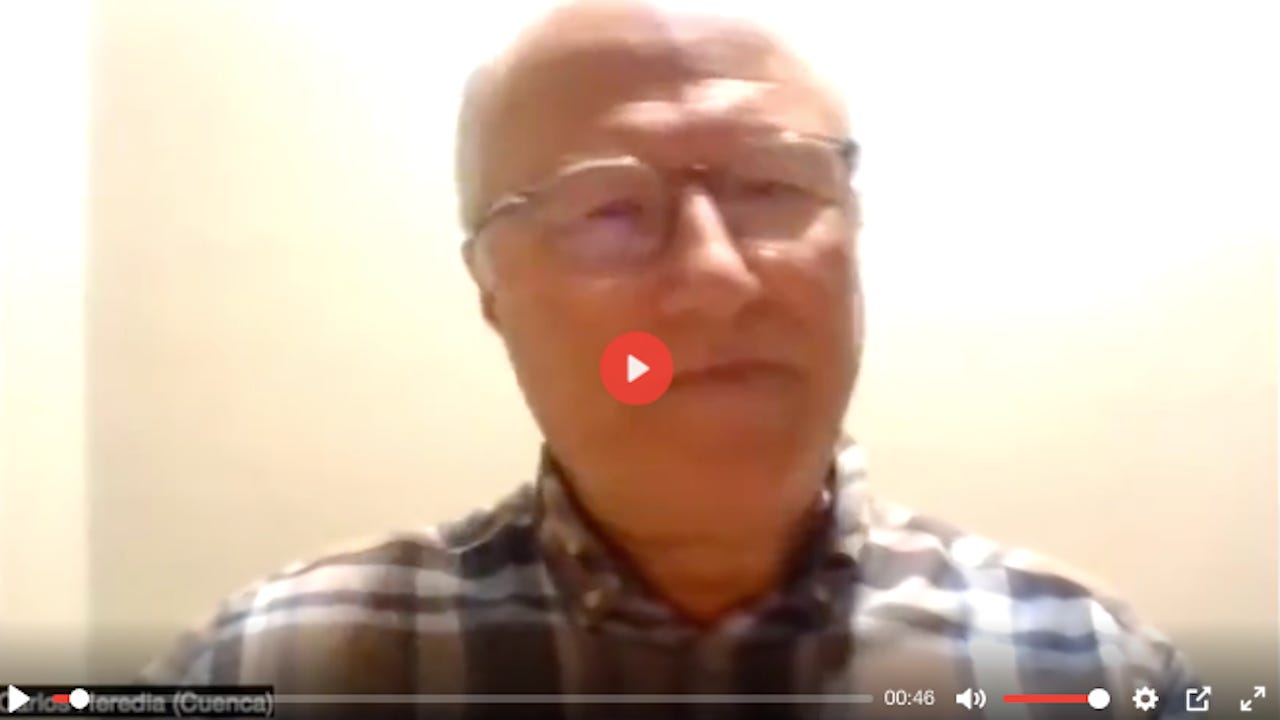




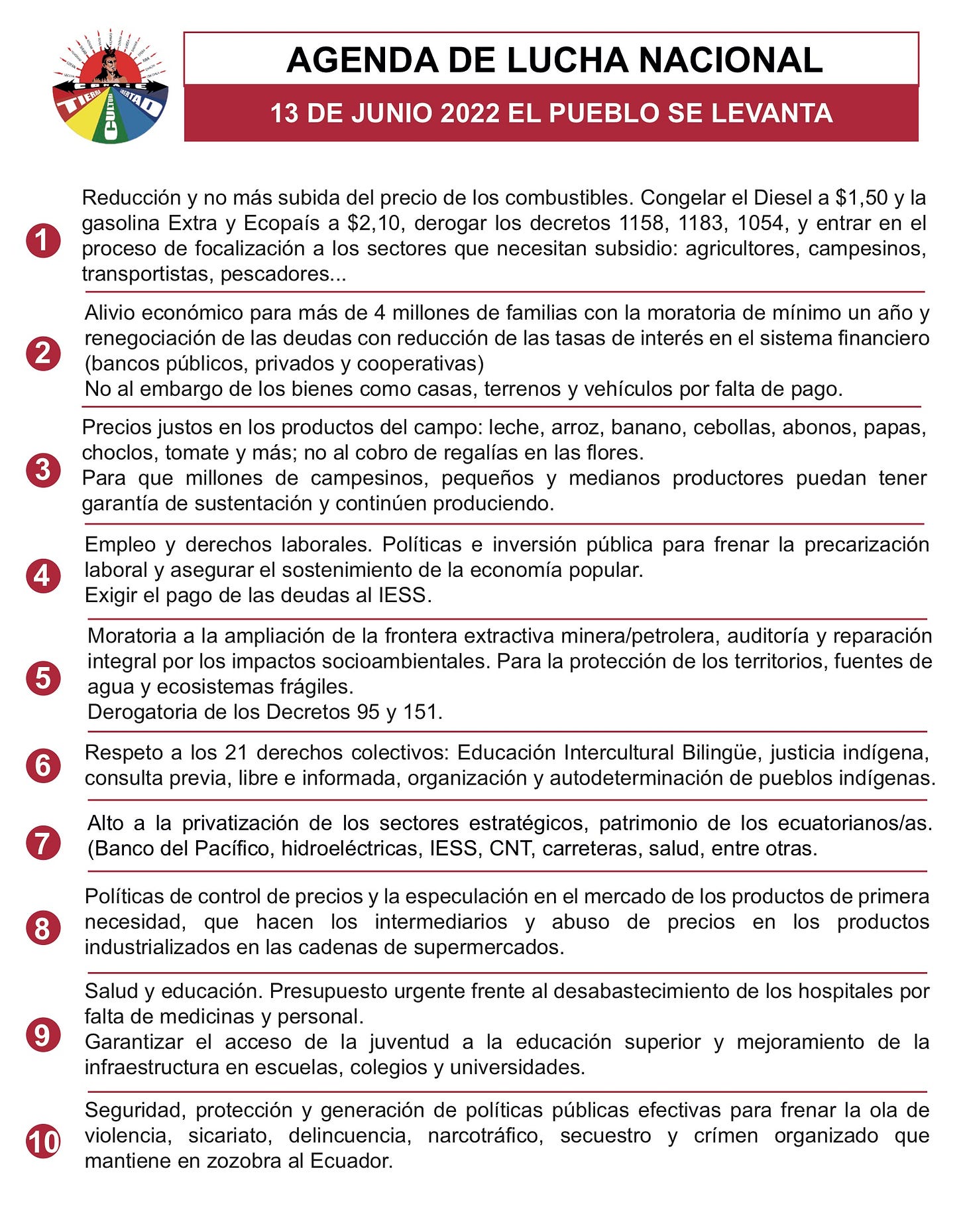




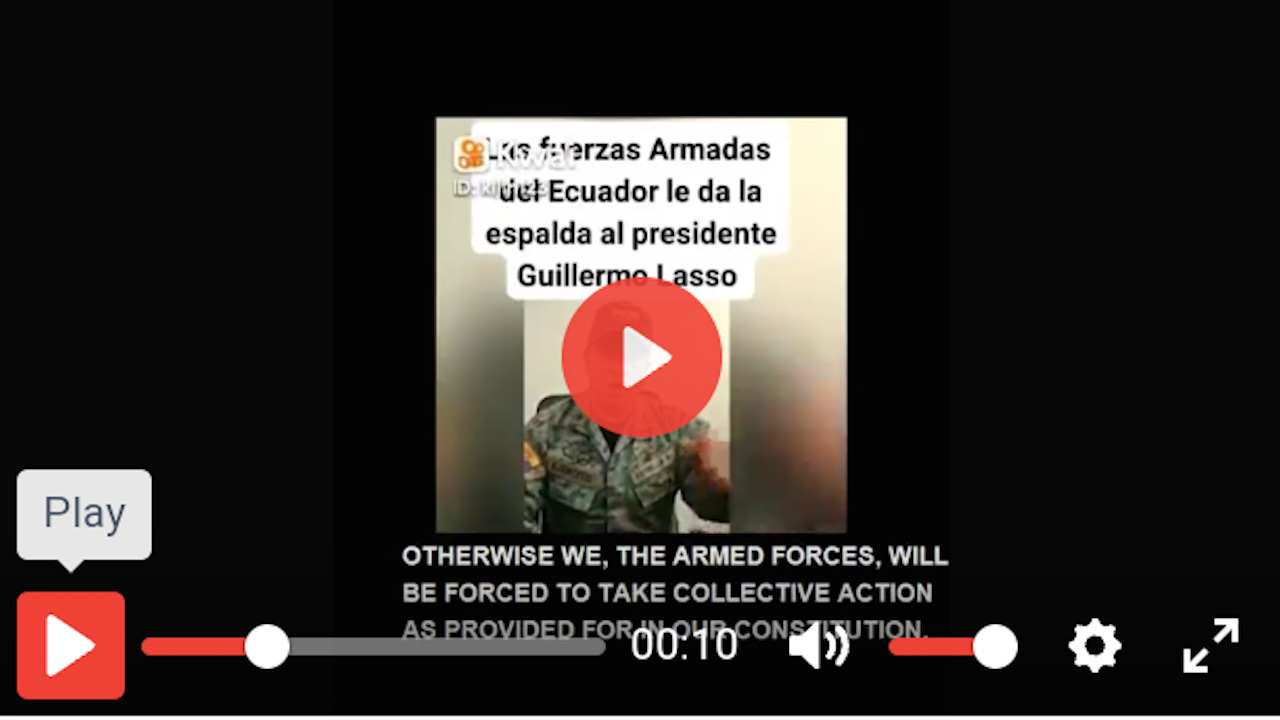
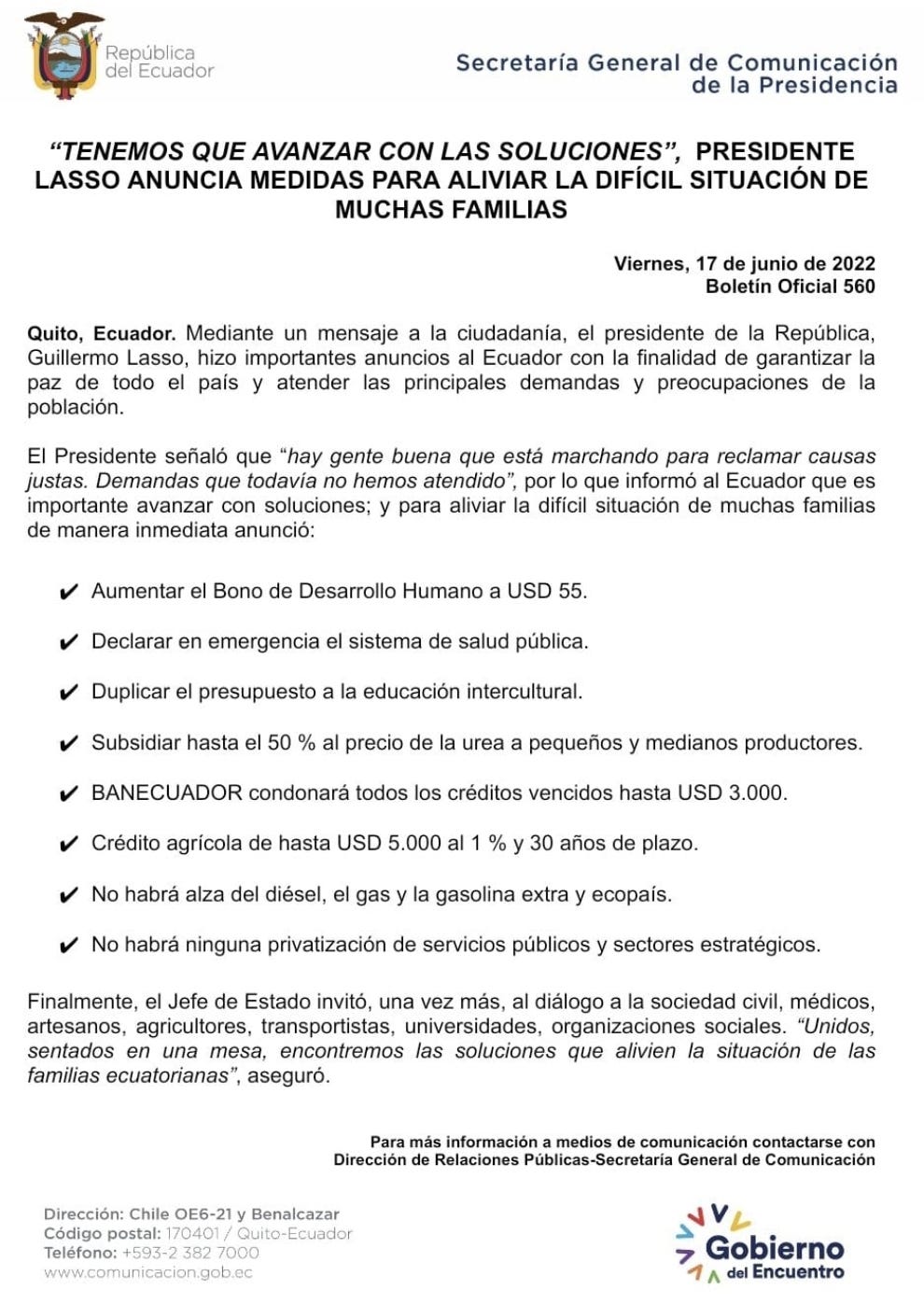


















James - Great article.
One of the stand out features of what is happening in Ecuador is that you can tell that it is a real organic uprising of very unhappy people. You can see the protest groups are messy, unorganized, and remind us of the Covid-19 freedom protests over the last 2 years, the Canadian and American truckers protests - they are organic because they are people that are united by their dissatisfaction, and come together as a group to protest.
But contrast it with the faked protests created by the World Economic Forum's deep state operatives - like the colour revolutions, the Myanmar protests, the South Korea truckers protests today adding to global supply chain disruptions, the climate change protests, the 'poor people's campaign' protests.
What do all these faked protests have in common? - which is why I call them out as fake.
1. they are all well organized and well disciplined
2. They all have the same shirts, the same head bands, the same signs
3. they all shout the same slogans
4. they are backed by flash webistes that raise money, agitate, and demand urgent action
5. they are backed by foundations and donors that lead back to the deep state and the World Economic Forum's billionaires
Give me an organic protest over a fake protest any day.
https://brandnewtube.com/v/MIjpvo